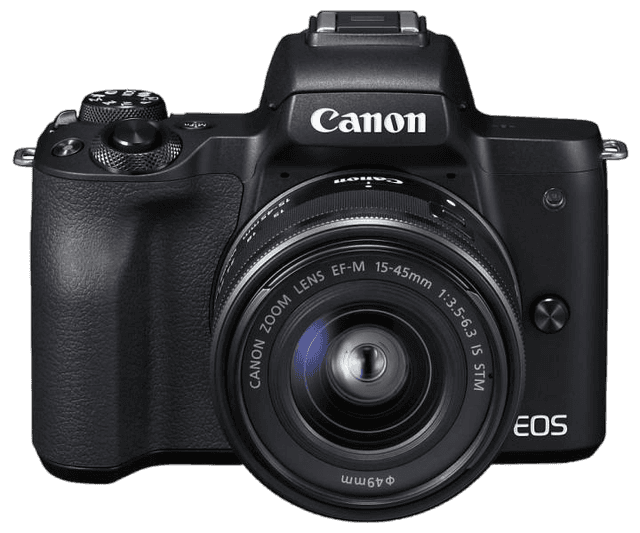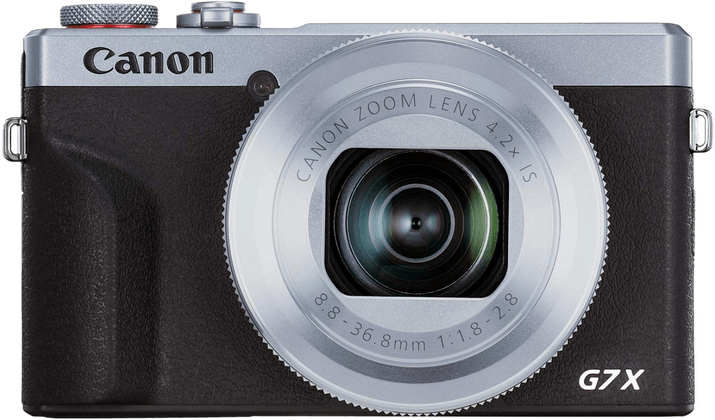Canon EOS M50 vs PowerShot G7 X Mark III Comparison
Canon EOS M50

Canon PowerShot G7 X Mark III

The Canon EOS M50 and Canon PowerShot G7 X Mark III both received a score of 59/100, indicating that they perform similarly in terms of general specifications. Both cameras were released in 2018 and 2019, respectively, with the M50 being a mirrorless camera and the G7 X Mark III being a compact camera. They share similar launch prices, with the M50 at $779 and the G7 X Mark III at $749.
The EOS M50 stands out with its larger size (116 x 88 x 59mm) and slightly heavier weight (390g), which may offer a more stable grip for some users. On the other hand, the PowerShot G7 X Mark III’s compact size (105 x 61 x 41mm) and lighter weight (304g) make it more portable and convenient for travel or everyday use.
In terms of specifications, both cameras have their strengths and weaknesses, making them suitable for different users and situations. The EOS M50’s larger size and weight may be preferred by those who prioritize stability and control, while the PowerShot G7 X Mark III’s compact design is ideal for those who value portability and convenience.
Canon EOS M50 vs PowerShot G7 X Mark III Overview and Optics
The Canon EOS M50 takes the lead in optics with a score of 59/100, compared to the Canon PowerShot G7 X Mark III’s score of 57/100. Both cameras share some common specifications, such as a CMOS sensor type, a Digic 8 processor, and a DXOMARK score of 58 for the sensor.
The EOS M50 has several advantages over the G7 X Mark III. With 24 megapixels, it offers higher resolution, allowing for more detailed images. Additionally, the EOS M50 features an APS-C sensor size, which is larger than the G7 X Mark III’s 1″ sensor size. This enables the EOS M50 to capture more light, resulting in better image quality in low-light conditions. Moreover, the EOS M50 has a Canon EF-M lens mount, providing the flexibility to change lenses depending on shooting requirements.
On the other hand, the G7 X Mark III has its own strengths. It boasts a shooting speed of 30, which is three times faster than the EOS M50’s shooting speed of 10. This makes the G7 X Mark III more suitable for capturing fast-moving subjects. Furthermore, the G7 X Mark III has built-in image stabilization, reducing the chances of blurry images due to camera shake.
Taking these factors into account, the Canon EOS M50 is the better choice for photographers who require higher resolution and better low-light performance, as well as the ability to change lenses. The Canon PowerShot G7 X Mark III, however, is more suitable for those who prioritize a faster shooting speed and image stabilization.
Canon EOS M50 vs PowerShot G7 X Mark III Video Performance
The Canon EOS M50 and the Canon PowerShot G7 X Mark III have identical video scores of 91/100, indicating that both cameras perform exceptionally well in this area. They share many video capabilities, including a maximum video resolution of 4K, maximum video dimensions of 3840 x 2160, and a maximum video frame rate of 120fps. Additionally, both cameras have built-in time-lapse functionality.
Despite having the same score, the Canon EOS M50 has some advantages over the PowerShot G7 X Mark III. The M50 is an interchangeable lens camera, which allows users to choose from a variety of lenses to achieve the desired video effect. This flexibility can significantly enhance the video quality and creative possibilities. Moreover, the EOS M50 has a larger sensor size, which contributes to better low-light performance and improved overall image quality in videos.
On the other hand, the Canon PowerShot G7 X Mark III has its own merits. As a compact camera, it is smaller and lighter than the EOS M50, making it more convenient for travel and on-the-go shooting. Additionally, the G7 X Mark III has a faster lens at its widest focal length, which can be beneficial for shooting videos in low light conditions and achieving a shallow depth of field.
Based on these points, the Canon EOS M50 is a better choice for those seeking flexibility and the ability to use different lenses for video production. However, the Canon PowerShot G7 X Mark III is more suitable for users who prioritize portability and convenience without sacrificing video quality. Both cameras offer exceptional video capabilities, making them strong contenders in their respective categories.
Canon EOS M50 vs PowerShot G7 X Mark III Features and Benefits
The Canon EOS M50 and Canon PowerShot G7 X Mark III both have a feature score of 70/100. These cameras share several specifications, making them quite similar in terms of features. Both cameras have a 3-inch screen size, 1040000-dot screen resolution, touchscreen capabilities, flip screens, and lack of GPS. Additionally, both cameras are equipped with WiFi and Bluetooth connectivity.
The Canon EOS M50 excels in some areas compared to the Canon PowerShot G7 X Mark III. The M50 has a larger sensor, providing better image quality and low-light performance. The camera also offers more autofocus points, which enables faster and more accurate focusing. Furthermore, the M50 has an electronic viewfinder, making it easier to compose and shoot in bright sunlight.
On the other hand, the Canon PowerShot G7 X Mark III has some advantages over the EOS M50. The G7 X Mark III is more compact and lightweight, making it more convenient for travel and everyday use. It also has a faster continuous shooting speed, which is beneficial for capturing fast-paced action or sports photography.
Considering these differences, the Canon EOS M50 is the better choice for those who prioritize image quality and autofocus performance. The electronic viewfinder is also a notable advantage, particularly for outdoor photography. However, the Canon PowerShot G7 X Mark III wins in terms of portability and continuous shooting speed, making it an attractive option for those who need a compact camera for travel or fast-paced photography. Both cameras have their strengths and weaknesses, and the choice ultimately depends on the user’s specific needs and preferences.
Canon EOS M50 vs PowerShot G7 X Mark III Storage and Battery
The Canon PowerShot G7 X Mark III outperforms the Canon EOS M50 in the storage and battery category with a score of 27/100, while the EOS M50 scores 13/100. Both cameras have one memory card slot, accepting SD, SDHC, and SDXC cards (UHS-I compatible). They also share the same battery life of 235 shots.
The G7 X Mark III has an advantage with its USB charging capability, making it more convenient for on-the-go charging. This feature is absent in the EOS M50, which relies on a separate charger for its LP-E12 battery.
Despite the lower score, the EOS M50 does not have any specific advantages over the G7 X Mark III in terms of storage and battery. The only difference lies in the battery type, with the EOS M50 using an LP-E12 battery and the G7 X Mark III using an NB-13L battery.
Considering the storage and battery aspects, the Canon PowerShot G7 X Mark III is a better choice due to its USB charging feature. The Canon EOS M50 does not offer any additional benefits in this category.
Canon EOS M50 vs PowerShot G7 X Mark III – Our Verdict
Are you still undecided about which camera is right for you? Have a look at these popular comparisons that feature the Canon EOS M50 or the Canon PowerShot G7 X Mark III:
